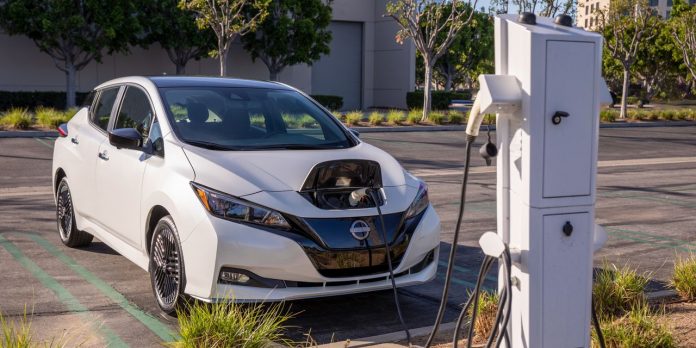Text size

The 2023 Nissan Leaf.
Courtesy of Nissan
Choosing whether to buy an electric vehicle can involve a tricky cost-benefit analysis.
In general, EVs are pricier than similar gasoline-powered cars, but fuel savings can narrow that gap. Government subsidies and high gasoline prices this year have tipped the balance increasingly toward EVs, to the point where the fuel savings can outweigh the higher sticker prices in less than a year, according to one analyst.
An Energy Department analysis released this week also found that battery-powered EVs generally spend less than $1,000 per year on the electricity for their vehicles, versus average fuel prices between $2,000 and $7,000 for gas-powered vehicles. EV owners are spared from the sticker shock that most drivers are experiencing today. Powering up a standard EV battery can cost $15 to $20 at current electricity prices, an enticing prospect when many people filling up on gas in recent months have been paying over $50.
Raymond James analyst Pavel Molchanov did the math in the last month on two similarly sized vehicles by the same manufacturer—the
Nissan
Sentra and the electric Nissan Leaf—to see how the economics played out.
Using 2021 car sticker prices, as well as 2021 gas and electricity prices, Molchanov found that it took 12 years for the Leaf’s lower power and maintenance costs to make up for the higher sticker prices, without considering the subsidy. The Leaf was selling for $32,765 versus $20,605 for the Sentra. Annual fuel savings for the Leaf were $652, and Molchanov calculated maintenance savings of $400 for the EV. Adding in the $7,500 government subsidy for the Leaf, the payback period narrowed to four years.
But the math got considerably better this year, according to Molchanov’s calculations. For one thing, the sticker price difference narrowed, with the Leaf costing $27,400 and the Sentra $19,510, for a gap of $7,890. In addition, the cost of gasoline has soared. Molchanov used a $4.50 per gallon average for the year, which is above current prices and the government’s latest annual estimate of $4.07. He also accounted for more-expensive electricity, using 14.5 cents per watt, which is about in line with the latest government figures.
All told, the fuel and maintenance savings for the Leaf versus the Sentra this year are $1,521, according to Molchanov. The payback period stands at five years, but that is eliminated when accounting for the government subsidy, which sets the two vehicles at essentially the same price. So all those fuel and maintenance savings become “icing on the cake,” Molchanov said in an interview.
The climate and healthcare bill that President Biden signed on Tuesday removes limits for the number of EVs that can be sold by each manufacturer and still receive a subsidy. Now, more people who buy EVs from
Tesla
(ticker: TSLA) and General Motors (GM) can get the $7,500 subsidy.
Molchanov’s back-of-the-envelope math will differ depending on the make and model of each vehicle, of course. And not everyone has the ability to pay residential electricity rates to power up their cars. Buying a specialized charger that can fully power a battery overnight—or faster—can cost over $1,000. And paying for vehicle charging in a city is often more expensive than hooking up at home. In New York City, for instance, city-run fast-charging stations cost 35 cents per kilowatt-hour, more than twice as much as the average national residential electricity rate.
In addition, consumers may value reliability more than price. EV chargers are spreading fast throughout the country, but in some areas they’re still relatively difficult to find. As chargers become more reliable and faster, however, the fuel savings are likely to become an even bigger selling point.
Write to Avi Salzman at [email protected]

